Date: 17 August, 2001
Port of Call: Southwest Harbor, Maine
Subject: Nova Scotia
We have found that, when traveling by boat, things often take longer than we expect. Sometimes a lot longer. So it was, that only two years after deciding to go to Nova Scotia, we finally arrived. We had planned to visit this Canadian maritime province the last time we came north in 1999, and we even had a few charts and a cruising guide. But engine problems and the advancing seasons got in the way, and we had to head south disappointed. This year, with a June arrival in Maine and everything working on the boat (as much as that can be said of a cruising boat), we decided to go for it.
We got off to a less than certain start when we tried to acquire the last few charts we needed of the Nova Scotia coastline. In mid-June of this year we had stopped in Newport, Rhode Island on our way north and cleaned out the Armchair Sailor Bookstore of most of the large-scale charts that we needed to complete our Nova Scotia chart inventory. Unfortunately, two essential charts were out of stock. The bookstore promised to mail the charts to us when they arrived "the next day". We gave them a General Delivery address in Southwest Harbor and continued on up the coast.
Two weeks later, when we checked with the post office in Southwest Harbor, no charts had arrived for us. Several conversations with the bookstore finally revealed that (despite our explicit instructions to use U.S. mail) they had tried to get Federal Express to deliver to an U.S. Postal Service general delivery address! They promised to re-ship via U.S. mail right away. One week, and many phone calls later, we were still without the charts. The bookstore finally determined that Federal Express hadn't returned the charts to Armchair Sailor when they couldn't deliver them to the Post Office; they simply dropped them at The Hinckley Company, on the assumption that any boater bound for Southwest Harbor would eventually wind up at Hinckley's. Hinckley's did indeed have our charts--they had been sitting right there in the office the couple of times we had visited! It felt like a scene from the movie "Castaway" as we walked away with our errant FedEx package.
Mt. Desert Island recedes astern
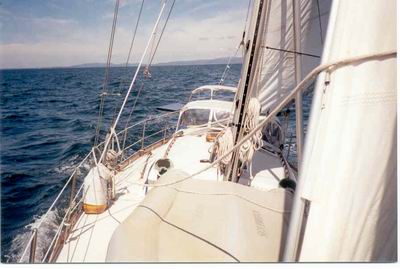 After the chart trouble, the passage itself was mostly uneventful.
We slipped our mooring in Southwest Harbor around 0830, topped up with fuel
at Hinckley's, and by 0900 we were heading out Eastern Way on a starboard
tack under a single-reefed main, staysail, and yankee. It was a nice
clear day, and we watched the bulk of Mt. Desert Island recede astern as
we accustomed ourselves to the rhythm of the swells. As the afternoon
breeze kicked in, the wind built to 15 to 18 knots and backed from south-southwest
to south. We reached along at 5 ½ to 6 knots. It was glorious
sailing. Shortly after sunset the wind died completely. We started
the engine and motored through the night, standing our watches as the moon
rose into a canopy of clouds. The only hitch on the passage was that
we were not able to find the buoy that was supposed to mark our landfall
in Nova Scotia. After double-checking the GPS and the chart, we determined
that it was the buoy, and not us, that was lost. A glimpse of
Cape Sable Light through the thickening early morning fog confirmed our position.
We motored the rest of the way into Shelburne without seeing any of the Nova
Scotian coastline.
After the chart trouble, the passage itself was mostly uneventful.
We slipped our mooring in Southwest Harbor around 0830, topped up with fuel
at Hinckley's, and by 0900 we were heading out Eastern Way on a starboard
tack under a single-reefed main, staysail, and yankee. It was a nice
clear day, and we watched the bulk of Mt. Desert Island recede astern as
we accustomed ourselves to the rhythm of the swells. As the afternoon
breeze kicked in, the wind built to 15 to 18 knots and backed from south-southwest
to south. We reached along at 5 ½ to 6 knots. It was glorious
sailing. Shortly after sunset the wind died completely. We started
the engine and motored through the night, standing our watches as the moon
rose into a canopy of clouds. The only hitch on the passage was that
we were not able to find the buoy that was supposed to mark our landfall
in Nova Scotia. After double-checking the GPS and the chart, we determined
that it was the buoy, and not us, that was lost. A glimpse of
Cape Sable Light through the thickening early morning fog confirmed our position.
We motored the rest of the way into Shelburne without seeing any of the Nova
Scotian coastline.We anchored in Shelburne, and I dinghied ashore to call Canadian Customs. They requested that we bring Sovereign to the town dock so they could board us. (We later learned that the Customs officers now refuse to dinghy out to boats because, a few days earlier, one of the officers had stepped on the gunwale of a less-than-stable dinghy and gone for a swim as a result.) When they arrived, the boarding officers were rather concerned that we were in possession of some pepper spray, which we had to surrender to them, but other than that things went smoothly. When they left we lowered the yellow quarantine flag from the starboard spreader and replaced it with the Canadian maple-leaf, signifying our official arrival in Canada.
Dories stacked on floor of Dory Shop
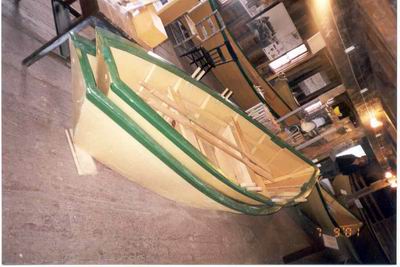 The next day we toured the town of Shelburne, visiting all the museums in
the historic waterfront district. Our favorite was the Dory Shop, which
still builds stackable wooden rowboats. In times past these were sold
to schooners engaged in fishing the Grand Banks, and due to their stacking
design, dozens could be stored on deck in very little space.
The next day we toured the town of Shelburne, visiting all the museums in
the historic waterfront district. Our favorite was the Dory Shop, which
still builds stackable wooden rowboats. In times past these were sold
to schooners engaged in fishing the Grand Banks, and due to their stacking
design, dozens could be stored on deck in very little space.The next few days we motored up the coast in unusual calms, stopping at Port Mouton (pronounced, we think, "mutt-TOON", though we heard some locals say "lah-TOON") and La Have. I would love to be able to describe the Nova Scotian coastline to you, but all we saw along this stretch was fog. Before making this trip, several people we met who had been to Nova Scotia said, as did the cruising guide, that Nova Scotia today is a lot like Maine of 50 years ago. We had to agree. This fog looked just like the fog we saw in Maine, and it can't have changed much in 50 years.
In La Have we stopped to visit Bert and May Cooper, the former owners of one of Sovereign's sisterships, who we had met during our last cruise of the U.S. East Coast in 1992-1993. Bert took us on a driving tour of the surrounding country, and as we rode inland the fog suddenly lifted, the temperature rose by about 10 degrees, and we were treated to a beautiful sunny summer day. The countryside rolled in green waves down to the river, until farms and houses gradually gave way to shopping malls and parking lots at the city of Bridgewater. As we returned back to the coast, the process gradually reversed itself as the cold water of the Atlantic reasserted its influence over the atmosphere.
Lunenburg waterfront
 The following day we moved on to Lunenburg, a lovely village which is trying
to find a balance between the coarse, rusty reality of a working fishing
fleet, and the slick manicured front of a seaside tourist town. From
the harbor, a myopic viewer might confuse the town with a strangely inverted
flower garden; the houses at the waterfront are painted in brilliant primary
colors: red, yellow, and blue, with roofs of green, red, and black.
More houses in similar shades are planted up the hillside, and as the eye
nears the crest above the harbor, an increasing covering of lush green trees
gradually obscures the houses until just a few supporting pillars, corner
posts, and flagpoles peek through the foliage like errant stems. Further
along the waterfront, a fleet of fishing boats lines the docks, and a marine
railway thrusts its rusty rails up the shore. We enjoyed walking around
the town, peering into the boutiques on the west side of town, and through
dusty storefronts on the east side that once held chandlers and shipping
agent offices.
The following day we moved on to Lunenburg, a lovely village which is trying
to find a balance between the coarse, rusty reality of a working fishing
fleet, and the slick manicured front of a seaside tourist town. From
the harbor, a myopic viewer might confuse the town with a strangely inverted
flower garden; the houses at the waterfront are painted in brilliant primary
colors: red, yellow, and blue, with roofs of green, red, and black.
More houses in similar shades are planted up the hillside, and as the eye
nears the crest above the harbor, an increasing covering of lush green trees
gradually obscures the houses until just a few supporting pillars, corner
posts, and flagpoles peek through the foliage like errant stems. Further
along the waterfront, a fleet of fishing boats lines the docks, and a marine
railway thrusts its rusty rails up the shore. We enjoyed walking around
the town, peering into the boutiques on the west side of town, and through
dusty storefronts on the east side that once held chandlers and shipping
agent offices.Deer on Zwicker Island
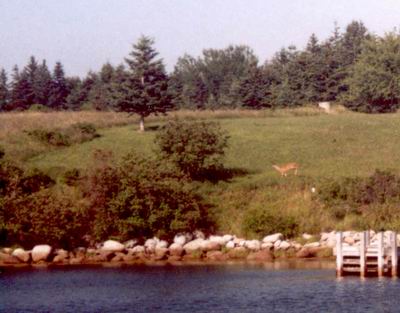 After a day in Lunenberg, we poked Sovereign's bow back into the fog and
worked our way--using all our "senses" of compass, knot log, depthsounder,
GPS, and radar--through a labyrinth of little islands in western Mahone Bay.
As we approached the mainland the fog gradually lifted, and we were able
to see a scattering of islets offering plenty of protected spots to anchor.
We picked an island with an unoccupied farmhouse perched atop a green apron
of a lawn and settled in for the evening. At dusk we saw a deer grazing
at the verge where the lawn met the forest. A pair of loons swimming
off the point serenaded us with their plaintive call.
After a day in Lunenberg, we poked Sovereign's bow back into the fog and
worked our way--using all our "senses" of compass, knot log, depthsounder,
GPS, and radar--through a labyrinth of little islands in western Mahone Bay.
As we approached the mainland the fog gradually lifted, and we were able
to see a scattering of islets offering plenty of protected spots to anchor.
We picked an island with an unoccupied farmhouse perched atop a green apron
of a lawn and settled in for the evening. At dusk we saw a deer grazing
at the verge where the lawn met the forest. A pair of loons swimming
off the point serenaded us with their plaintive call.The next morning, well rested from a peaceful night in a quiet anchorage, we got an early start and motored northeast across Mahone Bay. Our anchorage for the night was Deep Cove, a narrow slot reaching a mile inland to a snug harbor nestled in the shadow of several tall hills. Visibility was better, but the wind was still unexpectedly light, and we wound up motoring the whole way. At the entrance, the cliffs on the port hand side fall sharply into the water, and we kept to the deepest water just a boatlength or two off the shore. The cruising guide described this harbor as a hurricane hole, and we agree that even a strong breeze would have a tough time making it past the protection of the rim of granite that protects this little finger of water.
Neil and Jean’s, where all our e-mail goes
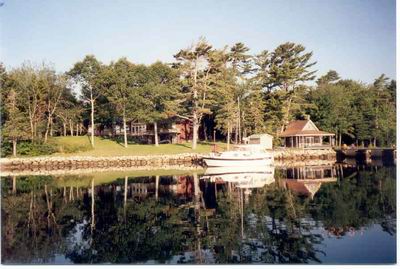 After another restful night in another calm harbor, our destination the following
day was at the head of St. Margarets Bay, some 20 miles away. We started
out motoring again, but the windless weather pattern that had plagued our
trip this far had finally broken, and by the afternoon we were sailing up
the bay in a building southwesterly tail wind. We were headed for the
home of Neil and Jean Hughes, who run one of the ham radio e-mail gateways
that we use to send all of these messages. We arrived about 1630, and
Neil was out on his lawn waiting for us, directing us to a vacant mooring.
After another restful night in another calm harbor, our destination the following
day was at the head of St. Margarets Bay, some 20 miles away. We started
out motoring again, but the windless weather pattern that had plagued our
trip this far had finally broken, and by the afternoon we were sailing up
the bay in a building southwesterly tail wind. We were headed for the
home of Neil and Jean Hughes, who run one of the ham radio e-mail gateways
that we use to send all of these messages. We arrived about 1630, and
Neil was out on his lawn waiting for us, directing us to a vacant mooring.A quiet cove near Dover, Nova Scotia
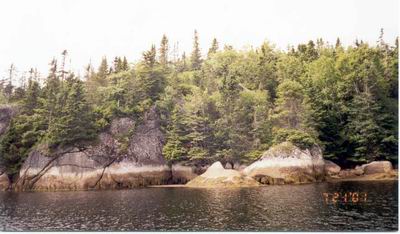 We spent the next five days getting to know Neil and Jean, and enjoying their
hospitality. As boaters they knew exactly what we needed--they opened
their home to us, took us shopping, and offered us hot showers and the use
of their laundry room. Neil solved a persistent problem I had with
my radio e-mail setup, and we played around with his ham gear while Cathy
and Jean went shopping and compared notes on needlecraft. One day we
went on a cruise in their powerboat to the tiny harbor of Peggy's Cove and
explored the rock-strewn passages near the village of Dover. Though
we are on a boat virtually all the time, this trip was a special treat for
us, because we wound through narrow little passages and went places we never
would have taken Sovereign. Our last day with the Hughes was rather
exciting. First, we watched a dog-overboard situation right in front
of the house (we went out to assist, but the dog had already been retrieved
by the time we arrived). Then we watched as a powerboat drove over
one of Neil's moorings and wrapped the mooring pendant around his propeller.
It took a good two hours of effort and 30 minutes of me swimming in the frigid
Nova Scotia water (yikes that was cold!) to clear that mess up. Then
in the evening, Neil was asked by a neighbor to help with a through-hull
fitting that had sprung a leak earlier that day, so we went over to lend
a hand there. You should understand that all of this happened directly
behind the house, on a tiny channel that sees less boat traffic than some
of the most deserted spots we have seen in the U.S. Trouble, it is
said, comes in threes, so we didn't worry too much that some other misfortune
was waiting to pounce upon us.
We spent the next five days getting to know Neil and Jean, and enjoying their
hospitality. As boaters they knew exactly what we needed--they opened
their home to us, took us shopping, and offered us hot showers and the use
of their laundry room. Neil solved a persistent problem I had with
my radio e-mail setup, and we played around with his ham gear while Cathy
and Jean went shopping and compared notes on needlecraft. One day we
went on a cruise in their powerboat to the tiny harbor of Peggy's Cove and
explored the rock-strewn passages near the village of Dover. Though
we are on a boat virtually all the time, this trip was a special treat for
us, because we wound through narrow little passages and went places we never
would have taken Sovereign. Our last day with the Hughes was rather
exciting. First, we watched a dog-overboard situation right in front
of the house (we went out to assist, but the dog had already been retrieved
by the time we arrived). Then we watched as a powerboat drove over
one of Neil's moorings and wrapped the mooring pendant around his propeller.
It took a good two hours of effort and 30 minutes of me swimming in the frigid
Nova Scotia water (yikes that was cold!) to clear that mess up. Then
in the evening, Neil was asked by a neighbor to help with a through-hull
fitting that had sprung a leak earlier that day, so we went over to lend
a hand there. You should understand that all of this happened directly
behind the house, on a tiny channel that sees less boat traffic than some
of the most deserted spots we have seen in the U.S. Trouble, it is
said, comes in threes, so we didn't worry too much that some other misfortune
was waiting to pounce upon us.We had to cut our trip to Nova Scotia short, because we had purchased plane tickets out of Bangor, Maine for our upcoming family reunion at the beginning of August. With the time ticking down, we had to make St. Margaret's Bay the terminus of our cruise and begin heading back.
Castle in Southwest Cove, NS
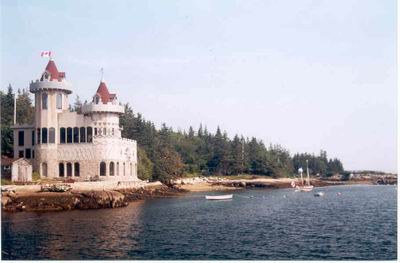 The normal seasonal southwesterly winds that had refused to appear to help
move us along on our way "down east" now kicked in just when we didn't want
them. We spent the next few days raising anchor early and motoring
in the lighter morning winds to arrive at a harbor before the afternoon sea
breeze reinforced the southwesterlies. We spent one night in Southwest
Cove in view of a small waterfall and (believe it or not) a castle, and were
entertained by the antics of a sailing club who rafted their boats together
for the night and then re-anchored en masse four times (!) as their anchors
dragged. Then the forecast changed, promising northerly winds, and
we hoped for a pleasant ride back down the coast. Each day the forecast
promised northerlies, and each day we wound up motoring in light southwesterlies,
stopping for the night in Lunenburg, the La Have Islands, and Brooklyn before
finally returning to Shelburne near the end of July.
The normal seasonal southwesterly winds that had refused to appear to help
move us along on our way "down east" now kicked in just when we didn't want
them. We spent the next few days raising anchor early and motoring
in the lighter morning winds to arrive at a harbor before the afternoon sea
breeze reinforced the southwesterlies. We spent one night in Southwest
Cove in view of a small waterfall and (believe it or not) a castle, and were
entertained by the antics of a sailing club who rafted their boats together
for the night and then re-anchored en masse four times (!) as their anchors
dragged. Then the forecast changed, promising northerly winds, and
we hoped for a pleasant ride back down the coast. Each day the forecast
promised northerlies, and each day we wound up motoring in light southwesterlies,
stopping for the night in Lunenburg, the La Have Islands, and Brooklyn before
finally returning to Shelburne near the end of July.Shelburne Founder’s Day
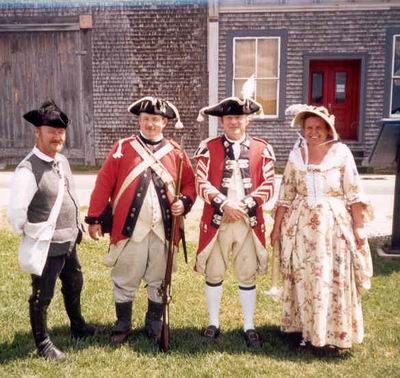 Our arrival in Shelburne happened to coincide with the Founder's Day celebrations
there, and we spend a day watching dory races, whirlygigs, a greased pole
contest, and a lumberjack show while waiting for good weather to cross back
to Maine. We didn't have long to wait as it turned out. The next
day's forecast (the U.S. forecast that is, for I had grown skeptical of the
long string of errors from Environment Canada) suggested south to southwesterly
winds and slight seas. We rose early and were under way by 0430 to
catch the turn of the tide off Cape Sable at around 1000. By early
afternoon the forecast wind had filled in, and we sailed along at four to
five knots, close-hauled on a starboard tack, riding a knot and a half of
favorable current. We sailed along in pleasant conditions, the windvane
steering while we kept watch. During late afternoon, Cathy spotted
two groups of whales while I was below napping. That evening the sun
set on a perfectly clear horizon. About five hours later a perfect
sunkist-orange moon followed the sun's path below the horizon. Except
for an hour of engine running to charge the batteries the next morning, we
sailed all the way to the entrance of Southwest Harbor, and only dropped
the sails as the wind died in the lee of Greening Island. We cleared
back in with U.S. Customs a short 23 days after our original departure from
Maine.
Our arrival in Shelburne happened to coincide with the Founder's Day celebrations
there, and we spend a day watching dory races, whirlygigs, a greased pole
contest, and a lumberjack show while waiting for good weather to cross back
to Maine. We didn't have long to wait as it turned out. The next
day's forecast (the U.S. forecast that is, for I had grown skeptical of the
long string of errors from Environment Canada) suggested south to southwesterly
winds and slight seas. We rose early and were under way by 0430 to
catch the turn of the tide off Cape Sable at around 1000. By early
afternoon the forecast wind had filled in, and we sailed along at four to
five knots, close-hauled on a starboard tack, riding a knot and a half of
favorable current. We sailed along in pleasant conditions, the windvane
steering while we kept watch. During late afternoon, Cathy spotted
two groups of whales while I was below napping. That evening the sun
set on a perfectly clear horizon. About five hours later a perfect
sunkist-orange moon followed the sun's path below the horizon. Except
for an hour of engine running to charge the batteries the next morning, we
sailed all the way to the entrance of Southwest Harbor, and only dropped
the sails as the wind died in the lee of Greening Island. We cleared
back in with U.S. Customs a short 23 days after our original departure from
Maine.The whole time we were in Nova Scotia, we kept comparing and contrasting what we saw there with the way things are in Maine. In some ways the places are quite similar: they both share the same rocky, glacier-carved geology, with granite islands capped with pointed fir trees; they share a similar weather pattern of thick morning fog and afternoon southwesterly sea-breezes. In some ways Maine and Nova Scotia are different only by subtle degrees: Nova Scotia has cooler weather provided by the colder offshore water (I measured it at 44 °F); the seas are higher there (despite our experience of mostly calm winds); it is less densely populated than Maine, and has fewer boats and facilities; it has more room to anchor. And in some ways they are quite different: Nova Scotia had absolutely no lobster buoys (lobster season closes there during the summer); it grants the right of free passage to any person across all waterfront property, including the right to tie up to a dock.
In the end, I finally gave up on my expectations and trying to make comparisons. It was worth going there, and it is worth another visit. The only thing that I expect is, to return to Nova Scotia will probably take longer than I expect.
Smooth sailing,
Jim and Cathy